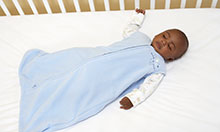Follow Sleep Guidelines to Keep Babies Safe and Reduce Risk of SIDS
 Every week in Ohio, three babies die in unsafe sleep environments. Fortunately, reducing the risk of Sudden Infant Death Syndrome (SIDS) and sleep-related infant deaths is as easy as following the ABCs:
Every week in Ohio, three babies die in unsafe sleep environments. Fortunately, reducing the risk of Sudden Infant Death Syndrome (SIDS) and sleep-related infant deaths is as easy as following the ABCs:
A. Alone: Baby always sleeps alone. Baby’s caregiver should be nearby (the same room is best) but not in the same bed.
B. Back: Baby sleeps on his back – not stomach or side – every time he sleeps. Baby will not choke if he spits up; babies are actually less likely to choke on their backs.
C. Crib: Baby sleeps in a bare crib. That means no bumper pads, pillows, blankets, stuffed animals or toys in the crib. Anything in the crib can become a suffocation risk. Only a crib, bassinet or pack ‘n play should be used for baby to sleep. It is not safe for baby to sleep in an adult bed, on a sofa or chair, air mattress or any other soft surface.
S. Smoke-Free: Baby sleeps in a smoke-free home. Babies who are exposed to second-hand smoke have an increased risk of dying from SIDS.
Additional Sleep Tips
In addition to the ABCs listed above, there are several other things you can do to help your baby sleep as safely as possible:
- Breastfeed: research shows that breastfeeding helps protect infants from SIDS.
- Use a pacifier at nap time and bed time once breastfeeding has been established.
- Avoid letting baby get too hot; do not over bundle and keep the room temperature comfortable for a lightly clothed adult.
- Use a Sleep Sack or other wearable blanket; do not use loose blankets in the crib.
- Follow the American Academy of Pediatrics schedule of recommended vaccines.
- Avoid alcohol and drug use during pregnancy and after baby is born.
- Make sure everyone who cares for your baby knows and follows the ABCs of safe sleep.
Additional Resources for Safe Sleep
For more information on infant safe sleep check out the following resources:


